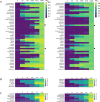The Anticancer Drug Bleomycin Shows Potent Antifungal Activity by Altering Phospholipid Biosynthesis
- PMID: 36036637
- PMCID: PMC9602507
- DOI: 10.1128/spectrum.00862-22
The Anticancer Drug Bleomycin Shows Potent Antifungal Activity by Altering Phospholipid Biosynthesis
Abstract
Invasive fungal infections are difficult to treat with limited drug options, mainly because fungi are eukaryotes and share many cellular mechanisms with the human host. Most current antifungal drugs are either fungistatic or highly toxic. Therefore, there is a critical need to identify important fungal specific drug targets for novel antifungal development. Numerous studies have shown the fungal phosphatidylserine (PS) biosynthetic pathway to be a potential target. It is synthesized from CDP-diacylglycerol and serine, and the fungal PS synthesis route is different from that in mammalian cells, in which preexisting phospholipids are utilized to produce PS in a base-exchange reaction. In this study, we utilized a Saccharomyces cerevisiae heterologous expression system to screen for inhibitors of Cryptococcus PS synthase Cho1, a fungi-specific enzyme essential for cell viability. We identified an anticancer compound, bleomycin, as a positive candidate that showed a phospholipid-dependent antifungal effect. Its inhibition on fungal growth can be restored by ethanolamine supplementation. Further exploration of the mechanism of action showed that bleomycin treatment damaged the mitochondrial membrane in yeast cells, leading to increased generation of reactive oxygen species (ROS), whereas supplementation with ethanolamine helped to rescue bleomycin-induced damage. Our results indicate that bleomycin does not specifically inhibit the PS synthase enzyme; however, it may affect phospholipid biosynthesis through disruption of mitochondrial function, namely, the synthesis of phosphatidylethanolamine (PE) and phosphatidylcholine (PC), which helps cells maintain membrane composition and functionality. IMPORTANCE Invasive fungal pathogens cause significant morbidity and mortality, with over 1.5 million deaths annually. Because fungi are eukaryotes that share much of their cellular machinery with the host, our armamentarium of antifungal drugs is highly limited, with only three classes of antifungal drugs available. Drug toxicity and emerging resistance have limited their use. Hence, targeting fungi-specific enzymes that are important for fungal survival, growth, or virulence poses a strategy for novel antifungal development. In this study, we developed a heterologous expression system to screen for chemical compounds with activity against Cryptococcus phosphatidylserine synthase, Cho1, a fungi-specific enzyme that is essential for viability in C. neoformans. We confirmed the feasibility of this screen method and identified a previously unexplored role of the anticancer compound bleomycin in disrupting mitochondrial function and inhibiting phospholipid synthesis.
Keywords: Cryptococcus neoformans; PS synthase assay; ROS; antifungal drug; bleomycin; inhibitor; mitochondria; phosphatidylserine synthase.
Conflict of interest statement
The authors declare no conflict of interest.
Figures





References
-
- Day JN, Chau TTH, Wolbers M, Mai PP, Dung NT, Mai NH, Phu NH, Nghia HD, Phong ND, Thai CQ, Thai LH, Chuong LV, Sinh DX, Duong VA, Hoang TN, Diep PT, Campbell JI, Sieu TPM, Baker SG, Chau NVV, Hien TT, Lalloo DG, Farrar JJ. 2013. Combination antifungal therapy for cryptococcal meningitis. N Engl J Med 368:1291–1302. doi: 10.1056/NEJMoa1110404. - DOI - PMC - PubMed
Publication types
MeSH terms
Substances
Grants and funding
LinkOut - more resources
Full Text Sources
Molecular Biology Databases

